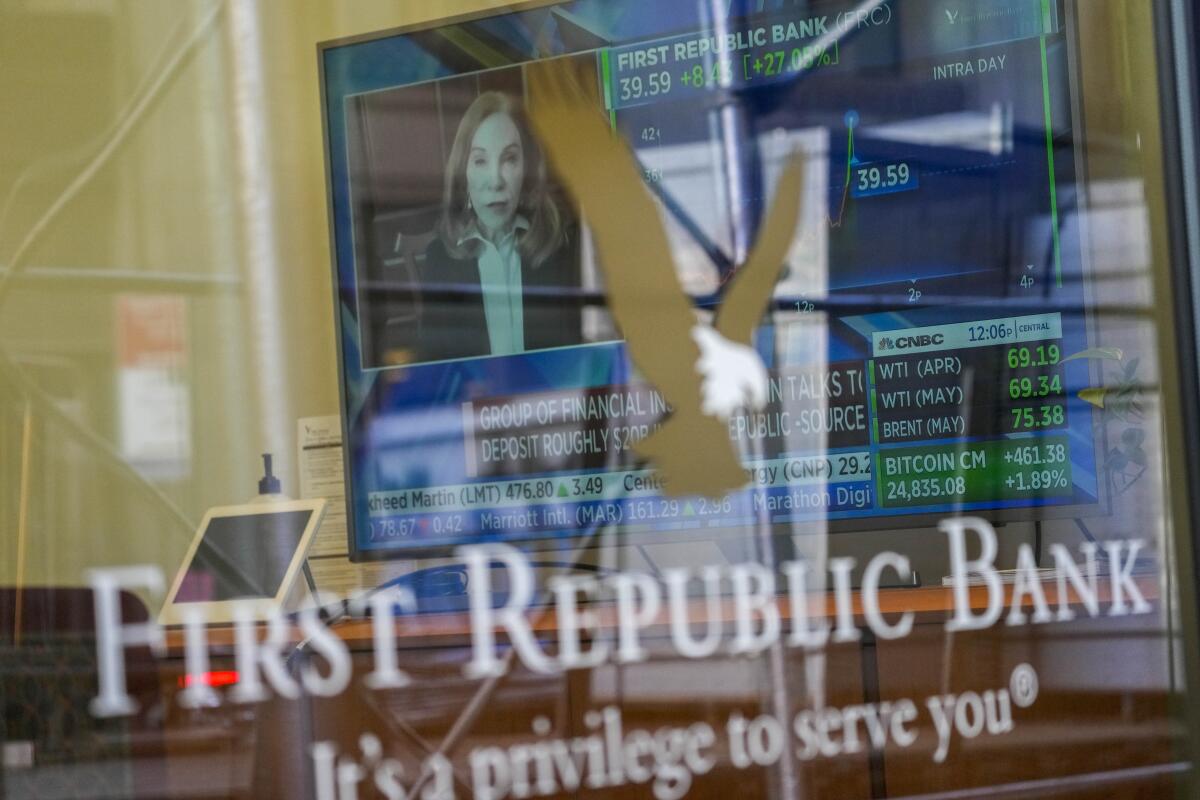Opinion: Yes, rescuing banks like First Republic rewards the reckless. No, that shouldnāt stop us

Every financial crisis starts with the untimely demise of a canary in a relatively small metaphorical coal mine. The death is sudden and tragic, and the authorities are āshocked, shocked to find that gambling is going on in here.ā
Reluctant governmental support is nevertheless quickly provided to the financial victims and to prevent collateral damage to the banking system ā for example, the protection of elderly depositors in the run on the British bank Northern Rock in 2007 and, this month, of tech sector companies in the case of Silicon Valley Bank. And then things get serious.
For the record:
10:57 a.m. March 18, 2023An earlier version of this article misstated the number of years since the Trump administrationās rollback of banking regulations under the 2010 Dodd-Frank law. It is five years, not seven.
On March 10, Silicon Valley Bank was done in by uninsured depositors rushing to withdraw their funds, fearing the bankās potential insolvency. The bankās vulnerability was the result of poor risk management and weak regulatory supervision. By last weekend, with the prospect of bank runs spreading, the federal government moved to make all uninsured depositors whole at SVB and at Signature Bank, which New York authorities closed on Sunday.
On Thursday, 11 of the largest U.S. banks, in a move coordinated by the Biden administration, announced that they would deposit $30 billion into First Republic Bank to fortify its finances and bolster confidence in the banking system.
This weekās canary in a larger mine was Credit Suisse, which received emergency financial support on Wednesday from the Swiss National Bank in the form of $54 billion in loans.
But the European Central Bank apparently does not believe in canaries, so it moved to raise interest rates another half-point on Thursday, even though the Eurozone is facing potential instability and presumed weak financials among its banks. At the same time, reports surfaced of European bank regulators criticizing the support that was provided to SVBās uninsured depositors. One European official said U.S. authorities displayed ātotal and utter incompetenceā in violating global standards and setting a dangerous precedent for further bailouts.
This is a different kind of warning signal, which indicates we have reached Stage 2 of the current crisis: the debate over whether bailouts and lifelines create a āmoral hazardā that rewards the reckless ā in this case, bank executives ā for taking bad risks without forcing them to bear the cost of their actions.
A significant interest rate increase and such rhetoric at this crisis moment indicate real potential for a policy mistake in the Eurozone. If faltering stability becomes a problem for euro-area banks, what will the authorities do? We can probably expect the discussion in European capitals to be very similar to what happened in Washington last weekend.
Threaded through the debate about a financial bailout is this notion of moral hazard. This may be a fascinating question, but itās something of a political monster.
We regulate and supervise banks to keep moral hazard under control. When a run on a bank occurs, the question is always: Should we provide unsavory support for banks, even though this will obviously increase their incentive for poor performance and bad behavior in the future? Or should we simply let them fail?
There is a certain antimodern, punitive aspect to these discussions. First, moral hazard among bankers is indeed bad, as they will take more bad risks when they fear the consequences less. Second, impending bank failures demonstrate that excessive moral hazard is already among us. It is already well documented that Silicon Valley Bank failed because its management was not careful; there are also concerns among observers about Credit Suisse in this regard. But do we really want to allow the pain to fall where it may despite the damage imposed on innocent bystanders?
U.S. Treasury Secretary Andrew Mellon reportedly advised President Herbert Hoover to āliquidate labor, liquidate stocks, liquidate the farmers, liquidate real estate.ā That was in the early 1930s, and this thinking ā āpeople will work harder, lead a more moral lifeā after a financial collapse ā was a major part of what brought us the Great Depression.
Obviously, we should make every effort to prevent bank runs from happening by improving regulation, strengthening capital requirements and making supervision more effective. The banking sector, however, always pushes back, demanding deregulation and arguing (without basis) that the rules impede American enterprise and innovation. This counterargument is starting already, with ridiculous claims to confuse the narrative, such as that SVBās problem was that it was too left-wing.
In fact, the core problem is always that the people who run banks are compensated based on return on equity, unadjusted for risk. Consequently, they want as much leverage ā higher debt compared to equity ā as possible. These executives also want to take as much risk as they can get away with. With this combination, in the good times they earn millions, and in the bad times they walk away, and we as a society have to deal with the costs.
The financial reforms imposed by Dodd-Frank lasted eight years before there was a significant rollback under the Trump administration. Now, after five years under lighter official scrutiny, the financial sector is again primed for a reckoning.
We need to guard against policies that create moral hazards, but context is everything. Allowing significant losses for SVBās uninsured depositors would have resulted in a massive flood of deposits out of smaller and regional banks and into safe havens (big banks and Treasury debt). That flight of money would have ruined many, perhaps thousands, of otherwise sound banks.
The immediate banking crisis may have been tempered, but it isnāt over. As concerns about moral hazard rise again in Europe, will European regulators succumb to the temptation to make an example of some bank or other? One thing is certain: What they do will have global consequences, including for the U.S., and we will need to be prepared for them.
Simon Johnson is a co-chair of the CFA Institute Systemic Risk Council, former chief economist of the International Monetary Fund and professor at MIT Sloan.
More to Read
A cure for the common opinion
Get thought-provoking perspectives with our weekly newsletter.
You may occasionally receive promotional content from the Los Angeles Times.










